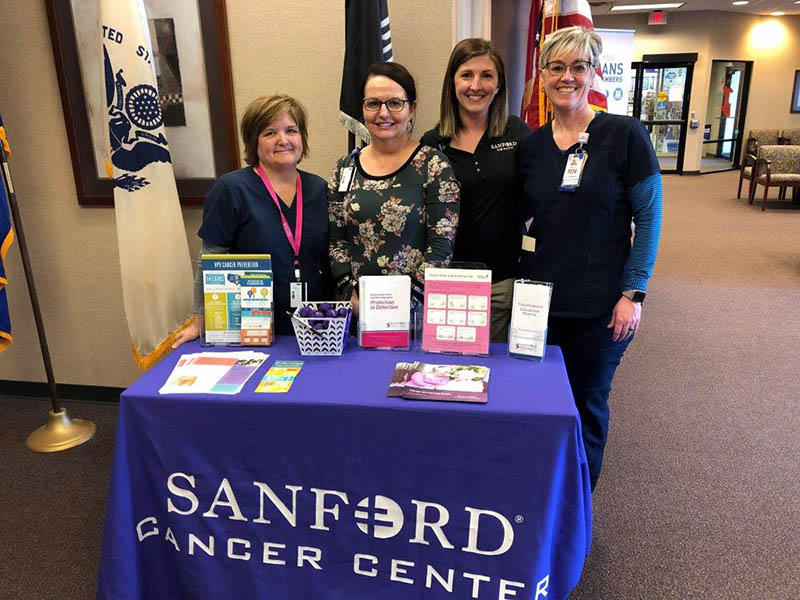A clinic’s cancer screening event serves as a great reminder to patients of the importance of screening tests.
As it turns out, being part of a clinic team planning a cancer screening event is also a great reminder to keep up with screening tests.
For Sanford Health nurse supervisor Shelly Thiewes, that reminder proved crucial to her health and future.
Thiewes had fallen several months behind on her own annual mammogram when her clinic hosted a women’s cancer screening day in April, offering mammograms, Pap tests and HPV injections.
“Busy schedule, you know. You don’t make time for yourself,” Thiewes said. “But with this cancer screening deal going on, I thought, I’ve gotta get in and get mine done.”
The appointments were filled up that day, but when the mobile 3D mammogram truck came back to her Brookings, South Dakota, clinic in early May, Thiewes made sure to schedule her mammogram.
Afterward, the 52-year-old received a request to go to the Edith Sanford Breast Center in Sioux Falls for a diagnostic mammogram. Because of her dense breast tissue, she was told the original screening wasn’t as complete as they’d like to see.
Learn more: Breast cancer screening options
Thiewes didn’t worry about that. She had seen the same thing happen with other patients who went on to find out they had nothing wrong.
‘One of the very fortunate ones’
After her diagnostic mammogram, Thiewes received a call back to go in for a biopsy of some calcifications. That resulted in a shock: a diagnosis of ductal carcinoma in situ, in which the breast cancer is contained to the milk ducts.
Then Thiewes discovered firsthand the benefits of the collaboration of a whole Sanford Health team — called a tumor board — that meets regularly. Those attending the meeting include surgeons, oncologists, radiation doctors, radiologists, pathologists, genetic counselors, plastic surgeons, nurse navigators and researchers.
They look at information about each patient who has a new breast cancer diagnosis and offer their input and expertise.
One person who looked at Thiewes’ images saw something else that didn’t quite look right. A second biopsy resulted in a diagnosis of invasive ductal carcinoma, or cancer growing beyond the milk ducts. A few abnormal cells were detected in Thiewes’ other breast as well.
“Thank goodness for Sanford,” Thiewes said of the tumor board’s diligence in reviewing each patient’s case.
Her surgical plan then changed from lumpectomy and radiation to a bilateral mastectomy with reconstructive surgery.
Thiewes is grateful her cancer was spotted before it had spread to any lymph nodes. “I am one of the very fortunate ones. Because we caught it so very early, I don’t have to do chemo. I don’t have to do radiation. I just have to do oral medication for about five to 10 years,” she said.
‘The best work family’
While Thiewes was able to avoid going through a rugged treatment regimen, her cancer journey wasn’t easy. Her diagnosis came on May 16, about two weeks before her daughter’s wedding.
She talked with her husband, and she told her mom. But she decided to wait until after the wedding to tell the rest of her family that she soon would face surgery for breast cancer.
The uncertainty weighed on her, along with the worry that her experience would affect her view of herself as a woman. And she didn’t know what to expect: “How bad is it going to be? What’s it going to be like afterwards? Are you not going to be here for your family, your grandkids?”
But through it all, Thiewes found support in many places.
Schedule a checkup: What health screenings do you need?
The members of her medical team were reassuring and great at explaining everything, especially the nurse navigators. “They walk you through it,” Thiewes said.
“They’ve just all been amazing and understanding and supportive. I can’t say enough good. And maybe I’m biased, but I don’t think so.”
In addition, Thiewes said, “faith did a lot for me. A lot of prayer and just giving it up.”
She also took the advice that she offers to others who face a similar situation: “Don’t be afraid to talk about it and let others know what you’re going through.”
During the six weeks that Thiewes spent recovering away from the clinic, her co-workers didn’t forget about her. Emotion rippled through her voice as she described their support.
“I have the best work family,” she said.
“They all went together, and they brought food to my house so I didn’t have to cook. … It’s such a family environment, and when one goes down, everybody’s right there to lift them up.”
‘Your heart breaks’ for other patients
Since Thiewes’ return to work, she finds herself relating to patients a little differently. She’s always been concerned about her patients, but she has a new level of sensitivity for them now.
“When they tell you their story, then it makes me get more teary-eyed now, too,” she said. “When you hear about some other patients that are really having a tough time, your heart breaks for them, and you wish you could hold their hand through it all.”
She also urges them to get their health screenings done. “Don’t wait. Get in. Get it done,” she said.
“It’ll save you so much heartache if you catch it sooner rather than later.”
More stories
- Breast cancer set nurse on a mission to help others
- Breast cancer surgeon Jesse Dirksen: A source of help and hope
- Breast cancer survivor’s kindness at event changes her life
…
Posted In Brookings, Cancer, Cancer Screenings, Imaging, Pathology, Women's
